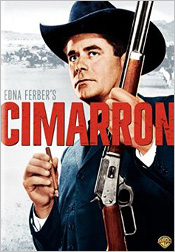 |
Site created 12/15/97.

page created: 2/26/09
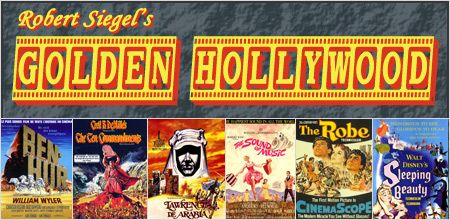 Robert Siegel - Main Page NOTE: The scans below are the property of Robert Siegel and The Digital Bits, and may not be reposted without permission. Copyright of the images belongs to the respective studios. In addition, please note that all the information contained within the text is taken from ORIGINAL studio press materials, which may contain some errors. |
||
Golden Hollywood - Introduction
Greetings classic fans! First, I'd like to thank all of the people who have taken time out of their busy schedules to send me an e-mail commenting on my column. Putting such a column together takes a lot of time and comments are most welcome. Most of the material you read in my column is from original studio press releases, and some of the behind the scenes information on these films is gathered from a multitude of different sources from the materials I have collected over the years. When I began writing this column for The Digital Bits, I felt that it would be much more interesting to show the original advertising art and promotional material than regular stills from the movies themselves. After all, you can find still photos from these films everywhere - they are used in magazines, online reviews, and just about everywhere a film is written about. But it's rare to find the vintage graphics that were used for the actual promotion, and I hope you are enjoying the nostalgic trip back to the golden days of Hollywood. So, now you know why I rarely use stills and opt for the more rare promotional graphic and poster art to accompany the text part of my column. For this column, I've selected five films that were released in the past six months for the first time on DVD or Blu-ray Disc. Each one shines in its own way. Shirley MacLaine did a wonderful job with Woman Times Seven, and I am sure you will enjoy the behind-the-scenes material I have located for the film. Warner Home Video's Cimarron received a fantastic new transfer with stereophonic sound, and the release of Becket was a delight to see on Blu-ray disc. Many Rivers to Cross may not have been a blockbuster for the studio, but the film also received a great new transfer. This MGM classic with Robert Taylor and Eleanor Parker is a great western, and I hope you enjoy the background material presented here. Last, but certainly not least, Image Entertainment released for the first time a DVD version of Fanny. Watching the film reminds us what Hollywood was all about in the golden era. They don't make them like this anymore, and we're presenting some great artwork and a few rare posters that were never used by the studio. When such films were being completed, the promotional departments of the studios went into high gear, and usually the artists were commissioned to present four or five different pieces of artwork to use for posters and ad slicks. Most of the time, only one was chosen as a main poster, but occasionally the studios would make available an alternate poster with different artwork. The main poster would be tagged Poster A, while the alternate B, and so-on. In other cases, some of the unused artwork (in the United States) was used for the main posters in other countries. I always try to include several of them in the column, and it's always fascinating to see different concepts of each film from the different artists. Please feel free to drop me a note with your comments and suggestions on this and future columns, and we'll see you at the movies! Rob Siegel Golden Hollywood Cimarron Film appreciation by Robert Siegel of The Digital Bits On August 26th, Warner Home Video released a completely remastered edition of the MGM's classic Cimarron, with a newly remastered stereo soundtrack. Cimarron is built around one of the most violent, rousing and exciting eras of American pioneer history, that followed the opening of the Oklahoma Territory and the great land rush of 1889. Everything about the picture was big, including stars Glenn Ford, Maria Schell, Anne Baxter, Arthur O'Connel, Vic Morrow and Charles McGraw. Its dynamic story covers a period of four decades, in which a lawless pioneer settlement of tents and shacks is grown into the thriving city of Osage. Most of the picture was filmed on location in Arizona, in Cinemascope and color, entailing MGM's biggest location movement within the United States and the studio's history. Creating the spectacular scenes which filled the screen required 10 cameras, a caravan of 50 boxcars and 35 trucks, 700 horses, 500 pioneer wagons and over 3,000 costumes. But the size and scope of Cimarron were never permitted to weigh down its rousing story of the men and women who opened up new frontiers of the West. Of these were Yancy Cravat and his young bride Sabra (Glen Ford and Maria Schell), whose sweeping love story, from the beginning of the land rush through the turbulent decades of Osage's growth, was as tempestuous as the bold era in which they played such vital pioneer roles. [Continued below...] |
||
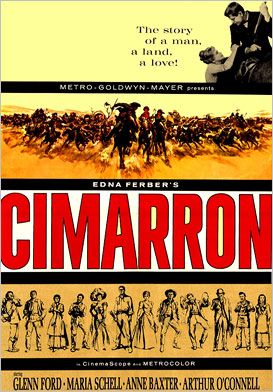 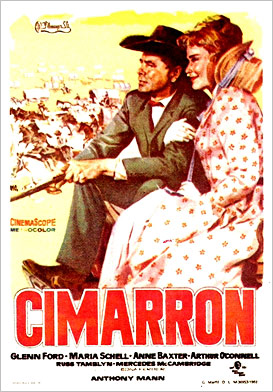 |
||
Edna Ferber's epic story is the tale of the first great land rush, opening a wild Indian country now known as Oklahoma to thousands of land-hungry settlers. MGM's filming was, at the time, the biggest American location trek in the studio's history. Culminating years of legislation, 11,000 quarter sections of 160 acres each were thrown open to homesteaders in an area known as the Unassigned Lands, in the heart of what was the original Oklahoma - a word meaning "red people" in Choctaw Indian language. Settlers came to the designated starting line in covered wagons, buggies, delivery carts and fancy surreys, with some riding horses which they brought from afar to enhance their chances. [Continued below...] |
||
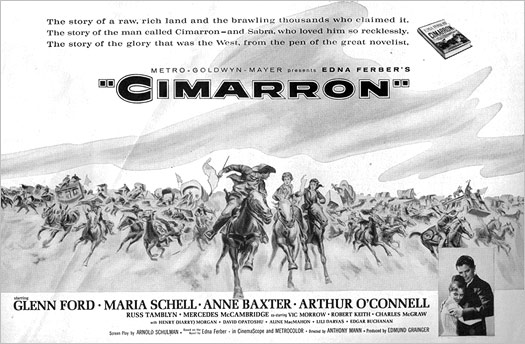
|
||
| Ms. Ferber, whose novels had a legion of readers during the 30 years previous to Cimarron, spent the longest time of her career creating this story. Ferber, as an author, dramatically utilized the entire era, covering a span of 40 years as the background for her love story. So did MGM. "The picture posed many problems and unique challenges because of the magnitude and variation of its settings," veteran producer Edmond Grainger said. "If there was one challenge bigger than the rest, however, it was the land rush." Grainger and director Anthony Mann selected a 20,000-acre prairie of two adjoining ranches in southeastern Arizona as their filming location. [Continued below...] |
||
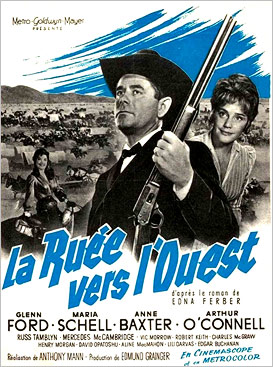  |
||
Additional roads were cleared over the area for the trucking of immense quantities of equipment, and headquarters were established in Tucson, 50 miles distant. More than 500 wagons, museum pieces of every size and description, were collected in Hollywood and restored to the best condition possible for the rough work ahead, then delivered to the location via train in 50 boxcars. Caravans totaling 35 trucks carried extensive camera, sound and lighting equipment, including the heavier Cinemascope cameras. Also transported were the wardrobe of over 3,000 costumes and thousands of props. Fifty horses, many of them trained to take spills without injury to themselves or their riders, also were transported to join 650 horses recruited from throughout the southwest. To handle them, 170 of the best horsemen in the area (and in Hollywood) were hired as wranglers. When filming began in Arizona, the movie troupe totaled 1,000 people. The movement of equipment and personnel from Hollywood was the biggest within the United States in MGM's history.
[Continued below...] |
||
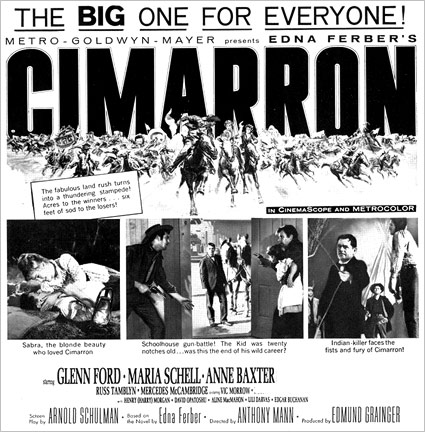 |
||
Through the wizardry of one of the screen's most skilled craftsmen, a warehouse full of inanimate objects were aged more than 30 years in the space of one week. The "magician" responsible for this was Hugh Hunt, one of the foremost set decorators in Hollywood at the time. For more than 35 years previous to Cimarron, Hunt had been selecting the furniture and odd pieces of bric-a-brac that filled rooms and sets in Hollywood's most important movies, the previous year having done another spectacular project in MGM's Ben Hur. Cimarron was to be his next project. "The changing times and their effect on small items gave us our biggest challenge," he explained. "In the home of Nancy and Sabra Cravat, we had 300 changes alone to show the gradual passage of 30 years. In one instance, because of the shooting schedule, we had to cover this span of time within one week's filming. A lamp, for example, had to be changed three times, from kerosene to gas and finally to an extremely rare 1914 Edison type globe. A dry kitchen sink of the 1800's was converted to a hand pump and later to brass faucets. The family organ, a standard instrument for many homes during the American expansion, was replaced by the piano. Gas was installed in place of an old wood burner. In subsequent stages of the story, the home of Yancey and Sabra acquired carpeted floors, papered walls and new draperies. A few sentimental items, such as old pictures and a crazy quilt, were retained throughout." To create the realism on the screen, Hunt enlisted the aid of MGM's research department. The latter spent hundreds of hours digging into the past to determine the props suitable to the story and authentic for the period. More than 500 pieces of rolling stock including Conestoga wagons, buckboards and tally-hoes were taken out of storage and sent to location. In contrast to the wagons and buggies were the horse-drawn trolley cars and horseless carriages, represented by a fine collection of early Oldsmobiles, Sears-Roebuck Coupes, Dijons and the largest Panhard touring car in the world, all of which were gathered for scenes showing Osage in 1912 and later.
[Continued below...] |
||
 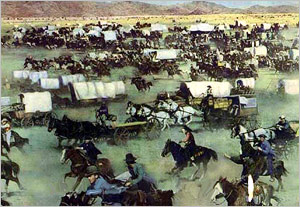 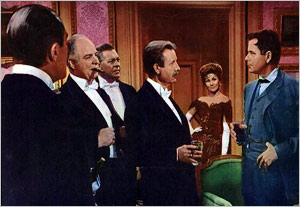  |
||
Starting with a troupe of more than 1,000 on location, scenes called for between 200 to 500 players, including the starting line camp sequence preceding the land rush, the stampede of settlers to the Government Land Office to file their claims, the first appearance of Osage as a rowdy frontier town and its later appearance through four decades as it grows into a modern metropolis. Two of the biggest sequences in size of crowds and of sets depict Osage in 1898, when Rough Rider heroes return from the Spanish-American War, and in 1906 when Osage became the center of Oklahoma's fabulous oil empire. Although he had photographed such world-famous beauties as Elizabeth Taylor and Ava Gardner, cameraman Robert Surtees was better known as Hollywood's "Master of Movie Spectacle." In an interview during filming, he said, "Big spectacle scenes are a challenge, but they don't assure an outstanding picture. Sometimes the intimate, confined scene is more important. And it can be more challenging to the cameraman too, especially using the wide Cinemascope process." This didn't mean that Surtees shrugged off the big scenes. He said he always got a thrill with each new spectacle sequence he photographed. Surtees won his first Oscar for King Solomon's Mines, which became remembered for its stampede of 2,000 wild animals from Africa. Since that time, he had filmed the gorilla hunt of Mogambo, the orgies of early Rome in Quo Vadis, the chariot race and sea battles of Ben-Hur and finally the historic land-rush in the Oklahoma territory in Cimarron. "The land rush is the spectacular scene of Cimarron," Surtees said. "We had hundreds of wagons, horses and people racing at top speed over a prairie in Arizona. We had as many as ten cameras shooting at one time from pits, towers, hilltops and moving camera cars. We spent two weeks to film it, and it gave us our biggest problems. Nevertheless, we worked just as meticulously on the scenes in small indoor sets, such as the love scenes between Ford and Miss Schell.
[Continued below...] |
||
 Collage of premiere photographs. |
||
The land rush certainly is the action highlight of the picture, but what will make the film outstanding is the people Edna Ferber wrote about and the drama that takes place between them." Surtees, a native of Covington, Kentucky, who began in motion pictures as an assistant cameraman in 1927, attributes the growing popularity of spectacle scenes to the broadening of the screen for Cinemascope. "The big scene and the big screen began as gimmicks," he declared. "The first such pictures were hits mainly because they were gimmicks. But at the time we filmed Cimarron, audiences were as critical of this type of picture as one filmed for the normal size screen. Fortunately, the men who make the pictures realize this. They know that a land rush or a chariot race is ideal for the big wide screen, but they also know it is what is achieved in the rest of the picture that counts. Fortunately, too, technical advancements kept pace with the increased know-how of the picture makers."
Glenn Ford was hired as the main actor. At the time, astronauts may seem to have had little in common with their forefathers who conquered the West, but you couldn't convince Ford of it. "They're cut from the same mold," Ford declared on the set, "They're today's pioneers with the same spirit that characterized the settlers of a hundred years ago. Adventure always has been part and parcel of America and our way of life. In those early days, there were always new worlds to conquer out West." Ford played such a character in Cimarron as Yancy Cravat, who has become a literary legend since Edna Ferber wrote her epic story. Through the story's 40-year span, Ford had to submit to extreme make-up changes and hardships. Ford considered this role to be the most important of his acting career and also admitted a personal partiality to it. "I've always liked variety in my work. But most of all, I dread being stuck inside studio sound stages, just playing in parlor dramas. In that respect, I feel like Yancey. When the town grows up around him and he finds himself being confined to a desk, he becomes restless and anxious to escape to new frontiers." Ford recalled that Cimarron contained the biggest fight he had ever filmed. The six-minute, knock-down drag-out battle, in which Ford fights a crowbar-wielding Vic Morrow and two henchman, took weeks to film. To heighten continuity, director Anthony Mann filmed the fight with two Cinemascope cameras. He also threw out the Marquis of Queenbury rule book and permitted the foursome to let fly with fists, spurred boots and leather harnesses in the brawl. Ford spent two hours as a "printer's devil" learning how to operate a high speed printing press of the Oklahoma land rush era. When the camera was set to film his scene, he confidently pushed the starting button of the press but failed to notice he had it set on high. The 75-year old mechanical monster spewed paper and ink in all directions, sending Maria Schell, Ford's co-star, and members of the crew diving for cover. Ford stood wide-eyed in the midst of the paper, covered in ink, waving his hands and shouting "Extra extra! Get 'em while they're hot." [Continued below...] |
||
 
Even in the 1980s, cross-promotions with movies were popular. |
||
Maria Schell, co-starring with Ford, was honored at virtually every international film festival. She had been honored with awards for many performances before her role in Cimarron. Few of those were exposed to American film audiences, but Ms. Shell's Hollywood debut opposite Yul Brynner in The Brothers Karamozov brought her wider recognition in this country. Her second Hollywood appearance with Gary Cooper in The Ganging Tree helped. As Sabra, the city-raised bride of the adventurous Yancey Cravet, Ms. Schell braved a new wilderness in her biggest adventure film to date. From a bride of 25, she also plays a grandmother of 65 thanks to the artistry of Hollywood make-up experts and her own acting talents. "On location in Arizona, we were on a prairie where you could look in any direction and see nothing but open land and hills in the distance," she said. "It made me realize for the first time what women who came into such wild country for the first time with their men, like Sabra did, must have experienced. In Arizona, we were visited one day by an elderly Indian wearing his feathered head-dress and beaded Indian clothes. He introduced himself as Robert Geronimo, and I was told later that he was the only living son of Geronimo, the famous Apache chief. He was born in 1889, the same year the scenes that we were filming took place. He pointed to some hills nearby and said these were the same hills from which his father had led raids on the white man."
[Continued below...] |
||
 Collage of premiere photographs. |
||
MGM spent months trying to cast eight pairs of twins for the film Cimarron. Five pairs appeared as twin children of Arthur O'Connell and Mercedes McCambridge. The other three alternated as the son of Glen Ford and Maria Schell, at the respective ages of three weeks, two years and five years. Production was completed after a long filming session of many months, and Cimarron was finally ready to release to the public after post-production. A short note: Anne Baxter, during filming, announced her engagement to the cast on location, and arranged the entire wedding on the set with dozens of calls to the back country of Australia, where her future husband, Randolph Galt, lived in New South Wales. They were married a week after filming ended. [Continued below...] |
||
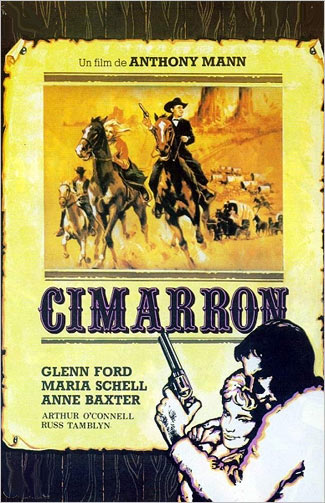 |
||
|
On to Page Two (Becket)...
 |
| Site
designed for 1024 x 768 resolution, using 16M colors and .gif 89a
animation. © 1997-2015 The Digital Bits, Inc., All Rights Reserved. billhunt@thedigitalbits.com |
